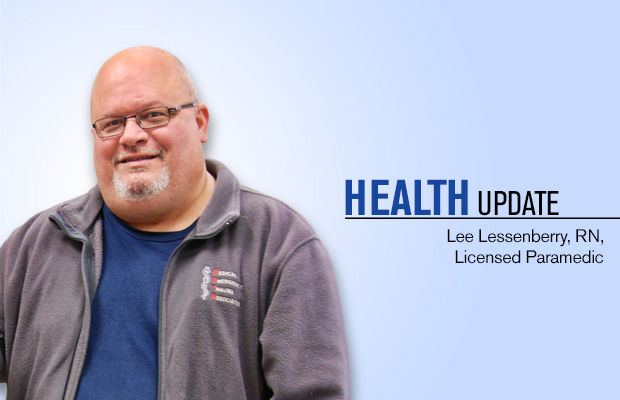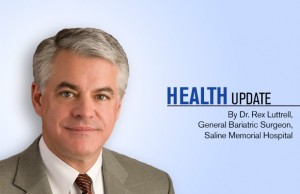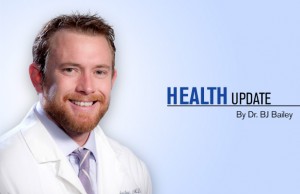Health Update: AR SAVES Helps Stroke Patients

Stroke is the third leading cause of death and the leading cause of permanent disability in Arkansas. Although there is cutting edge, world-class treatments approved to combat a stroke, the benefit of these treatments has remained out of reach to most Arkansans. In 2010, Saline Memorial Hospital shortened that reach through a partnership in the AR SAVES (Stroke Assistance through Virtual Emergency Support) Program. AR SAVES uses telemedicine to bring those interventions to people right here in Saline County.
Keith McClellan is a local patient who saw firsthand just how this new technology could save lives.
November 20, 2013 began as an ordinary Wednesday for McClellan; he was stirring about his home, contemplating surprising his wife for lunch, when suddenly something went terribly wrong. Already not able to see out of his right eye from an injury he suffered as a child, he now noticed his left eye seemed blurry and cloudy. He also noticed that he didn’t have “normal” use of his left arm and leg, they felt heavy and clumsy. Uncertain of what was happening, as fear and panic crept into his mind, he dialed 911.
What McClellan didn’t know was that he was having a stroke. Within moments of the 911 call, first responders from the Benton Fire Department and licensed paramedics from Saline Memorial Hospital’s Medtran Emergency Medical Services arrived at his house. Once back in the emergency department, McClellan was then evaluated using video teleconferencing by Dr. Margaret Tremwel, a vascular neurologist at Sparks Medical Center in Ft. Smith.
During this process, which took very few minutes to complete, Mr. McClellan continued to worsen. His motor function was worse, as he couldn’t control his own arm or leg on the left side of his body. Even more frightening, he was now sure that he would live the rest of his life blind–his only functioning eye was becoming useless to him at an alarmingly pace. Following a detailed neurological exam performed by the Saline Memorial Hospital staff and guided by Dr. Tremwel in Ft. Smith, Mr. McClellan was advised he should consider a new treatment that could improve his symptoms. The medication Activase, commonly known as TPA, can dissolve blood clots and restore function in many stroke patients. Mr. McClellan agreed to the medication.
Within 20 minutes of receiving the medication, Mr. McClellan noticed a change–the cloudiness in the left eye was beginning to go away. Within a few more minutes, he began to regain feeling in his left arm and leg with even more improvement with his eyesight. Twenty-four hours after coming to the emergency department at Saline Memorial Hospital, all symptoms of his stroke were gone–completely resolved.
To better understand how the AR SAVES program works, one must first understand Stroke and Stroke treatment. Simply put, a stroke is an interruption in the blood flow to a part of the brain resulting in the loss of function. How minor or severe the loss of function is depends on the size of the interruption in blood flow and the amount of brain affected. The stroke typically causes one or more of the following symptoms: drooping of the face, weakness/numbness in an arm, and a change in speech (usually slurring of words).
The cause of the interruption is typically a blood clot, which is the cause in nearly 90% of strokes. Once the blood clot forms and blocks blood flow to a part of the brain, the patient will begin to exhibit symptoms. If untreated, these symptoms have a high likelihood of resulting in permanent disability. The treatment for this type of stroke is a medication called TPA, a drug that dissolves newly formed blood clots and can restore blood supply to the effected brain tissue. It is the only medication approved for this type of use in strokes and has demonstrated great success in reducing stroke symptoms.
Historically, there have been several challenges to using TPA for stroke patients. A Vascular Neurologist specially trained in the medicines administration should be involved in the care of the patient. With such a limited number of those specialists available in Arkansas, this life altering treatment wasn’t available on a wholesale basis. In fact, the availability of this intervention was truly limited to a few specialty programs throughout the country.
Another challenge to a patient receiving this treatment is time. In order to be safe and effective, for most patients, TPA must be given within the first three hours of symptoms; for others the time can be up to 4.5 hours. This time begins with the first moment a change is noted that could be a stroke. By the time many patients arrive at their local hospital, there isn’t enough time remaining to perform the testing needed and then transfer the patient to a facility that could administer the medication.
The relationship between time and use of the clot buster TPA for a stroke patient is very similar to how ceramic tiles are glued into place. When you first place a tile, if it is crooked, you can straighten it out because the glue is still wet. If you wait a while, you cannot move the tile because the glue has dried. TPA works in a similar fashion. A new blood clot is held together by a specific “glue” that begins to “dry” over time. TPA will only dissolve the glue while it is still wet. The quicker you get it, the better it works.
Developed by UAMS in 2008, AR SAVES connects a stroke patient with a vascular neurologist through the use of interactive HD video. When a stroke patient reaches the Emergency Department at Saline Memorial Hospital, they are met by physicians and nurses who are specially trained in performing stroke assessments. An interactive video unit allows the vascular neurologist to observe the stroke exam performed by our staff, direct additional assessments, and interact with the patient and their family. In addition to being able to directly communicate with the patient, the AR SAVES system allows the Vascular Neurologist to view CAT scans directly, in real time.
The greatest challenge we still face in stroke care is time. It is disheartening to see people suffer a stroke and then wait to seek help. Often times, they simply wait too late.
Keith McClellan is very thankful, stating, “I had no idea what was happening to me, only that I was very afraid.” He went on to say he appreciated the professionalism and the “amazing efficiency” of the entire process, from the paramedics and fire fighters in the field to the doctors and nurses in the emergency department.
He also added, “I am convinced that I would be blind today if not for Saline Memorial Hospital’s participation in the program and the abilities of those who worked with me. I am forever grateful.”
Lee Lessenberry is a licensed paramedic and registered nurse who coordinates the stroke program at Saline Memorial Hospital.









0 comments